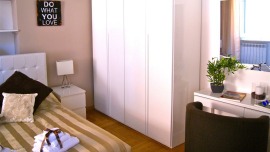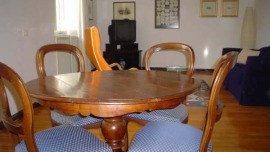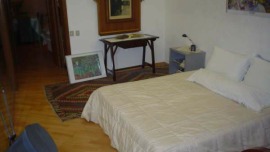Accommodation near Pantheon Rome
Pantheon
The Pantheon (/ˈpænθiən/ or US /ˈpænθiɒn/;Latin: Pantheon) is a building in Rome, Italy, commissioned by Marcus Agrippa during the reign of Augustus (27 BC - 14 AD) and rebuilt by the emperor Hadrian about 126 AD.
The building is circular with a portico of large granite Corinthian columns (eight in the first rank and two groups of four behind) under a pediment. A rectangular vestibule links the porch to the rotunda, which is under a coffered concrete dome, with a central opening (oculus) to the sky. Almost two thousand years after it was built, the Pantheon's dome is still the world's largest unreinforced concrete dome. The height to the oculus and the diameter of the interior circle are the same, 43.3 metres (142 ft).
It is one of the best-preserved of all Ancient Roman buildings. It has been in continuous use throughout its history, and since the 7th century, the Pantheon has been used as a church dedicated to "St. Mary and the Martyrs" but informally known as "Santa Maria Rotonda". The square in front of the Pantheon is called Piazza della Rotonda.
Etymology
Pantheon is derived from the Ancient Greek "Pantheon" (Πάνθεον) meaning "of, relating to, or common to all the gods": (Pan /"Παν" meaning "all" + Theon / "θεον"= meaning "gods").Cassius Dio, a Roman senator who wrote in Greek, speculated that the name comes either from the statues of so many gods placed around this building, or from the resemblance of the dome to the heavens. His uncertainty strongly suggests that "Pantheon" (or Pantheum) was merely a nickname, not the formal name of the building. In fact, the concept of a pantheon dedicated to all the gods is questionable. The only definite pantheon recorded earlier than Agrippa's was at Antioch in Syria, though it is only mentioned by a sixth-century source. Ziegler tried to collect evidence of panthea, but his list consists of simple dedications "to all the gods" or "to the Twelve Gods," which are not necessarily true panthea in the sense of a temple housing a cult that literally worships all the gods.
Godfrey and Hemsoll point out that ancient authors never refer to Hadrian's Pantheon with the word aedes, as they do with other temples, and the Severan inscription carved on the architrave uses simply "Pantheum," not "Aedes Panthei" (temple of all the gods). It seems highly significant that Dio does not quote the simplest explanation for the name—that the Pantheon was dedicated to all the gods. In fact, Livy wrote that it had been decreed that temple buildings (or perhaps temple cellae) should only be dedicated to single divinities, so that it would be clear who would be offended if, for example, the building were struck by lightning, and because it was only appropriate to offer sacrifice to a specific deity (27.25.7-10). Godfrey and Hemsoll maintain that the word Pantheon "need not denote a particular group of gods, or, indeed, even all the gods, since it could well have had other meanings…. Certainly the word pantheus or pantheos, could be applicable to individual deities…. Bearing in mind also that the Greek word θειος (theios) need not mean "of a god" but could mean "superhuman," or even "excellent."
Since the French Revolution, when the church of Sainte-Geneviève in Paris was deconsecrated and turned into the secular monument called the Panthéon of Paris, the generic term pantheon has sometimes been applied to other buildings in which illustrious dead are honoured or buried.
t:source: http://cs.wikipedia.org/wiki/PantheonLandmarks near Pantheon
-
Sant Agostino
290 yd ( 270 m ) from Pantheon -
Piazza Navona
340 yd ( 310 m ) from Pantheon -
Torre Argentina
480 yd ( 440 m ) from Pantheon -
Via del Corso
550 yd ( 510 m ) from Pantheon -
Palazzo Venezia
560 yd ( 510 m ) from Pantheon -
Trevi Fountain
610 yd ( 560 m ) from Pantheon -
Campo de Fiori Square
610 yd ( 560 m ) from Pantheon -
Piazza Venezia
620 yd ( 570 m ) from Pantheon -
Jewish Ghetto
770 yd ( 700 m ) from Pantheon -
Via Condotti
770 yd ( 710 m ) from Pantheon -
Quirinale
910 yd ( 830 m ) from Pantheon -
Piazza di Spagna
910 yd ( 830 m ) from Pantheon -
Synagogue of Rome
910 yd ( 840 m ) from Pantheon -
Sant'Angelo Castle
0.6 mi ( 980 m ) from Pantheon -
Roman Forum
0.6 mi ( 1 km ) from Pantheon -
Via Margutta
0.7 mi ( 1 km ) from Pantheon -
Metro station Barberini Fontana di Trevi
0.7 mi ( 1 km ) from Pantheon -
Metro station Spagna
0.7 mi ( 1 km ) from Pantheon -
Piazza Barberini
0.7 mi ( 1.1 km ) from Pantheon -
Via Nazionale
0.8 mi ( 1.2 km ) from Pantheon











